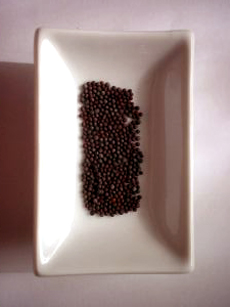
 Black mustard seeds. Photo by Meghan Anderson-Colangelo | SXC. Black mustard seeds. Photo by Meghan Anderson-Colangelo | SXC.
March 2006
Last Updated May 2012
|
 |
History Of Mustard & Mustard Glossary
Page 1: A Brief History Of Mustard
Unless you work at the Mustard Museum in Mount Horeb, Wisconsin, there are more different types mustards than you ever thought existed. And for good reason: Mustard is delicious, low-calorie and good for you. This is Page 1 of a seven-page glossary. Click on the black links below to visit other pages. See our other delicious food glossaries.
Historic Overview
Ask people to name a mustard, and most will recall French’s, Gulden’s, the generic Dijon (named after the city of Dijon, France) or Grey Poupon (a manufacturer based in Dijon). But many regions of France and other countries have their own mustard styles. Mustards have been popular for thousands of years because of the variety of flavors they impart to so many different foods.
White mustard (Sinapis hirta), a mild variety, grows wild in North Africa, the Middle East and Mediterranean Europe and has long been cultivated widely. Oriental mustard (Brassica juncea), the basis of American and European mustards as well as hot Chinese mustard, grows wild the foothills of the Himalayas. Black mustard (Brassica nigra) is believed to be native to the southern Mediterranean region.
The ancient Egyptians had mustard—grains of it have been found in the tombs of the pharaohs. The Greeks and Romans used the condiment. By the 1400s, mustard had spread through Europe: each region made its own style. Mustard came to America in the 1700s as immigrants set up their own businesses. The style of the day was strong, spicy and brown, and it was used sparingly. Gulden’s was founded in New York City in 1862, Plochman’s followed about 20 years later in Chicago.
In 1885, the French brothers started a flour mill and spice business in Rochester, New York that made mustard, but not until 1904 did Francis seek to create a different type of mustard—something milder so people would eat more of it. Bright yellow and creamy, French’s Cream Salad Brand Mustard was envisioned as as a cooking ingredient, e.g. for potato and egg salad. But it arrived just in time to meet the rise in popularity of the ball park hot dog—a match made in heaven. By the 1920’s, French’s outsold all other mustards by 5 to 1. So successful was the pairing that French’s incorporated the red pennants from Wrigley’s Field into its logo.
In 1957, Plochman’s introduced the squeeze bottle. It took almost 20 years—until 1974—for French’s to follow suit. By that time, America was entranced with a totally different mustard, Grey Poupon, an elegant Dijon mustard. In one early television commercial, a Rolls Royce window rolls down and the inhabitant asks for Grey Poupon.
Today, one can buy hundreds of fine, “gourmet” mustards: artisan-made, Champagne-based, herb- and fruit-flavored, or with the exotic tastes of China and Japan. In addition to being very tasty, mustards are extremely low in calories and carbohydrates (with the exception of sweet mustards, which have added honey or sugar products), and have no fat.
Read more about the history of mustard.
If you’re in the vicinity of Mount Horeb, Wisconsin, visit the Mustard Museum to see the largest assembly of mustards, mustard pots and related historic items.
MUSTARD TRIVIA
- Mustard is a cruciferous vegetable. Mustard greens are the leaves of the mustard plant). It is part of the genus Brassica, which also includes bok choy, broccoli, Brussels sprouts, cabbage, cauliflower, collards, kale, radish, rapeseed, turnips and other vegetables.
- Whole mustard seeds have no heat. Mustard seeds, from the flower of the mustard plant, don’t have heat and pungency until they are cracked and mixed with a liquid. This causes a reaction between two components of the seed (the enzyme myrosinase and the mustard oil glycosides), which produces a sugar and several chemical irritants.
Continue To Page 2: Mustard Types Beginning With A & B
Go To The Article Index Above

|